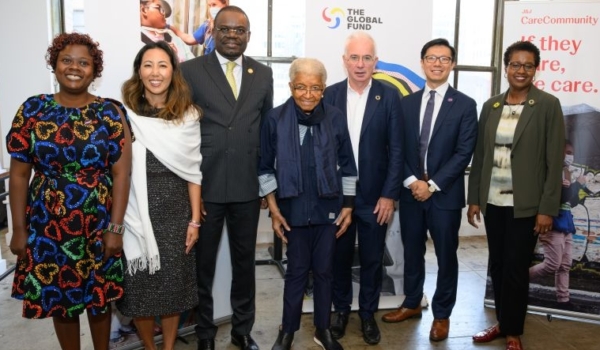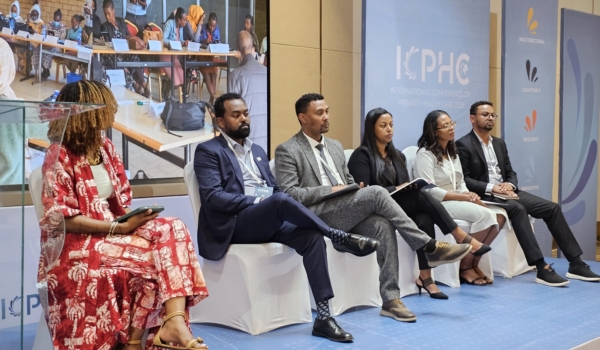The following is an excerpt from a manuscript developed by members of the Last Mile Health team.
Authors: Anne Holbrook McKenna, Kristin Johnson, Savior Flomo Mendin, Lisa R. Hirschhorn
The world marks a grim milestone this August 2020 – the novel coronavirus disease (COVID-19) has infected more than twenty million people and caused more than 750,000 deaths.1 As the burden of disease grows in low- and middle-income countries, health systems struggle to respond while still providing critical primary care.2 Community health workers (CHWs) can play an integral role in preventing, detecting, and responding to the COVID-19 pandemic.2,3
Public health emergencies heighten vulnerabilities of already disempowered and marginalized population groups and exacerbate health inequities.4,5 The differential effects of a pandemic have both biological and social determinants, with evidence showing that some men are more vulnerable to serious or deadly cases of the COVID-19.6,7 But focusing solely on this biological difference misses the important point that women are disproportionately affected by public health emergencies.4,5,8
Community health worker programs can, and should, play a key role in deliberately designed COVID-19 programs that are responsive to the socio-economic disparities, health inequalities, and gender-based violence experienced by women globally. To effectively mitigate the effects of COVID-19, community health worker programs must identify and address gender inequities in their design and response. They can do so by: meaningfully engaging women in all levels of implementation and program design; supporting ongoing access to essential sexual and reproductive health and other primary healthcare services needed to reduce child and maternal mortality; and supporting caregivers, who are mostly women, caring for those who fall ill from COVID-19 or other causes.
Ignoring the pandemic’s impact on women and girls, and their role in the response, will threaten our ability to stop the virus and could amplify its direct and indirect harm.9,10 The community health worker program must be designed to reflect the needs of the communities it serves; its response to COVID-19 must move beyond the “tyranny of the urgent” by confronting existing and emerging equity issues while addressing pressing medical needs.5
Program design and implementation at all levels must include women
Especially during public health emergencies, women are often underrepresented at the highest levels in global policy and decision-making spaces, and many leading publications ignore the influence of gender on health and other outcomes.11 Because women are frequently not engaged in the design of public health mandates, those mandates often do not consider women’s responsibilities during emergencies – for example, child caregiving that conflicts with isolation requirements – and increase risks of gender-based violence and sexual exploitation.5 At the community level, men often dominate formal community engagement processes and crisis communications, and health promotion materials may disregard women’s needs, roles, and power to implement recommendations.5,9,12Finally, absent or incomplete data disaggregation by gender results in inadequate information for evidence-based decision-making and gender integration into programming, including identification of existing or widening disparities before, during, and after pandemic response.11
To ameliorate these issues, community health worker program design and implementation must include women as decision-makers at all levels to inform context-appropriate policies and interventions, especially in the face of a pandemic. As one step to formalize gender dimensions in response efforts, governments and organizations should designate and mandate the authority of team members to integrate gender equity into their COVID-19 programming.4,5 Community engagement strategies should target women’s networks and organizations, not relying solely on formal gatekeepers, who are usually men.12
Culturally appropriate communications materials need to target women and reflect their agency, autonomy, and responsibilities. Strategies should specifically consider differences in access to and response to health information, with adaptations for different groups, including pregnant women and adolescent girls.
In addition, data collection and use are critical in the effective response to and tracking of the pandemic’s impacts, and community health worker programs must include women in the design and use of monitoring systems, data use, and research in pandemic response. All data, whether from routine activities, surveillance systems, or research should disaggregate by sex, age, and pregnancy status, and resources should be allocated to support monitoring, evaluation, and research on gender in the pandemic.
Sexual and reproductive health services must remain essential priorities
Decreased access to, and trust in, sexual and reproductive health services during public health emergencies reduces autonomy over birth planning and can disproportionately increase women’s mortality and morbidity.5,6,8,10Women face barriers to essential services, including family planning, ante- and post-natal care, facility delivery, and presence of skilled attendants at birth.5,6,8,10 Epidemics are also often accompanied by reductions in resource allocation to and interruption of sexual and reproductive health services to prioritize meeting urgent response needs.5,6,8,10 As a result, public health emergences, like the 2014-2016 Ebola outbreak, are often accompanied by reduction in access and uptake of key services, and increases in maternal, child, and infant mortality.5,8,10
Community health worker programs can mitigate or even prevent this additional risk for women through explicitly including strategies to maintain sexual and reproductive health and maternal care in COVID-19 programmatic response planning and resource allocation, recognizing that these services are essential to prevent avoidable morbidity and mortality.13 Community health workers should be supported to safely continue service provision, including safe approaches for direct care and education, making referrals and treatment plans for pregnant women to access care, and helping women address new obstacles to accessing services. Community health worker programs should also plan for disruption in their family planning supply chain and build inventory to reduce future stock-outs.
Women’s formal and informal role as caregivers must be supported, not exploited
Women face additional caregiving burdens during pandemics, such as holding responsibility for household disease prevention and response, caring for well and sick family members, and comprising 70% of the healthcare workforce.5,6,14 Unpaid caregiving provided by women in the home or workplace acts as a “shock absorber,” filling the gaps when health and social services cannot meet demand.11 Simultaneously, due to increased in-home responsibilities instead of outside paid work, women disproportionately lose financial and social power to negotiate their caregiving roles, household responsibilities, and safety from gender-based violence, as seen during the Ebola and Zika public health emergencies.4,11
Community health worker programs can support women who provide informal care for those with COVID-19 both through training for community health workers to directly provide safe care and referrals, and through providing support for informal caregivers’ health and safety. Steps to support informal community caregivers can include provision of materials for personal protection and education about COVID-19. Availability of personal protective equipment should extend beyond community health workers to health facility support staff (for example, cleaning and laundry staff, who are mostly women), and informal caregivers. Community health worker-led community education should emphasize safe care provision, without stigmatizing caregiving that requires touch.5
Conclusion
COVID-19 is not the first epidemic this century to exacerbate gender inequities; we have already seen how Zika and Ebola disproportionately affected women.5,11 The same patterns have already emerged in the COVID-19 response: the underrepresentation of women’s voices in global policy spaces, a disconnect between public health recommendations and the gender structures in which they are implemented, and the focus on urgently addressing medical needs at the cost of a gender equitable approach.4,6
Community health worker programs are well positioned to be a part of the solution. By responding to women’s needs and elevating their voices, we can support – not exploit – women’s integral roles in addressing a public health emergency. Allowing gender to be ignored in COVID-19 efforts will undermine the pandemic response, leading to direct and indirect harm and further entrenched gender inequities in health. We have the opportunity to set a new precedent—to leverage community health worker programs to support women and include women’s needs and perspectives in program design, decisions, and delivery. Gender integration is not a side issue; it is essential to an equitable and successful response to this pandemic.
References
- Novel Coronavirus (2019-nCoV) situation reports. https://www.who.int/emergencies/diseases/novel-coronavirus-2019/situation-reports.
- Prevent, detect, respond: How community health workers can help in the fight against covid-19. The BMJhttps://blogs.bmj.com/bmj/2020/03/27/prevent-detect-respond-how-community-health-workers-can-help-fight-covid-19/ (2020).
- Ballard, M. et al. Prioritising the role of community health workers in the COVID-19 response. BMJ Glob. Health 5, e002550 (2020).
- Davies, S. E. & Bennett, B. A gendered human rights analysis of Ebola and Zika: locating gender in global health emergencies. Int. Aff. 92, 1041–1060 (2016).
- Smith, J. Overcoming the ‘tyranny of the urgent’: integrating gender into disease outbreak preparedness and response. Gend. Dev. 27, 355–369 (2019).
- Wenham, C., Smith, J. & Morgan, R. COVID-19: the gendered impacts of the outbreak. The Lancet 395, 846–848 (2020).
- Márquez, E. J., Trowbridge, J., Kuchel, G. A., Banchereau, J. & Ucar, D. The lethal sex gap: COVID-19. Immun. Ageing 17, 13 (2020).
- Sochas, L., Channon, A. A. & Nam, S. Counting indirect crisis-related deaths in the context of a low-resilience health system: the case of maternal and neonatal health during the Ebola epidemic in Sierra Leone. Health Policy Plan. 32, iii32–iii39 (2017).
- Abramowitz, S. A. et al. Community-Centered Responses to Ebola in Urban Liberia: The View from Below. PLoS Negl. Trop. Dis. 9, e0003706 (2015).
- Mullan, Z. The cost of Ebola. Lancet Glob. Health 3, e423 (2015).
- Harman, S. Ebola, gender and conspicuously invisible women in global health governance. Third World Q.37, 524–541 (2016).
- High-Level Panel on the Global Response to Health Crises. Protecting humanity from future health crises: report of the High-Level Panel on the Global Response to Health Crises. 97 https://digitallibrary.un.org/record/822489 (2016).
- Hall, K. S. et al. Centring sexual and reproductive health and justice in the global COVID-19 response. The Lancet 395, 1175–1177 (2020).
- WHO | Delivered by Women, Led by Men: A Gender and Equity Analysis of the Global Health and Social Workforce. WHO http://www.who.int/hrh/resources/health-observer24/en/.




